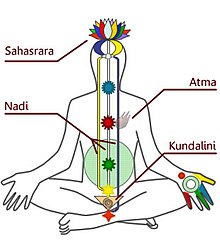According to yogic philosophy, kundalini is a spiritual energy or life force located at the base of the spine. It is conceptualized as a coiled up serpent. Literally, kundalini or kundala is that which is coiled (Sanskrit kund, to burn; kunda, to coil or to spiral). It is believed that Kundalini yoga is that which arouses the sleeping Kundalini Shakti from its coiled base through the 6 chakras,
and penetrate the 7th chakra, or crown. This energy is said to travel
along the ida (left), pingala (right) and central, or sushumna nadi - the main channels of pranic energy in the body.This process can be seen depicted even today in modern medical
iconography as two snakes spiraling a central staff, and although the
origin of this image is more directly derived from the Caduceus of the Greek god Hermes, it may express the same or a similar principle.
As popularly taught in the under the system of Yogi Bhajan, the
system is tailored as a comprehensive spiritual system for personal
growth using kriya exercises, pranayama, and meditations along with
mantras and dharmic teachings relating to Sikhism
. A common mantra used in this form is that of "Sat Nam" - meaning "I am truth".
The yoga form was originally shared as alternative and transformational technology for self-development, and to counter the drug abuse of the 60's, but has emerged as a comprehensive spiritual practice with global popularity.
Technically, Kundalini energy is understood as being sparked during yogic breathing when prana and apana
blends at the 3rd chakra (naval center) at which point it initially
drops down to the 1st and 2nd chakras before traveling up to the spine
to the higher centers of the brain to activate the golden cord - the connection between the pituitary and pineal glands - and penetrate the 7 chakras.
Borrowing and integrating the highest forms from many different
approaches, Kundalini Yoga can be understood as a tri-fold approach of Bhakti yoga for devotion, Shakti yoga for power, and Raja yoga for mental power and control. Its purpose through the daily practice of kriyas and meditation in sadhana are described a practical technology of human consciousness for humans to achieve their total creative potential.
According to one school of thought, there being four main forms of yoga, Mantra yoga, Hatha yoga, Laya yoga and Raja yoga; Kundalini yoga is really considered a Laya yoga.
Mainstream traditions propose that kundalini energy
can be awakened and enlightenment attained by practicing a combination
of yogic techniques—ideally following the guidance of a certified
teacher—including the use of mantra, prana and breathing techniques, sadhana, asana practice, meditation, or purely through devotion and prayer.
According to some Hindu traditions, Kundalini yoga is considered a
highly developed spiritual awakening which relies upon a technique
called shaktipat to attain enlightenment under the guidance of a spiritual master.
In the classical literature of Kashmir Saivism kundalini is described
in three different manifestations. The first of these is as the
universal energy or para-kundalini. The second of these is as the
energizing function of the body-mind complex or prana-kundalini. The
third of these is as consciousness or shakti-kundalini which
simultaneously subsumes and intermediates between these two. Ultimately
these three forms are the same but understanding these three different
forms will help to understand the different manifestations of kundalini .
The word 'Kundalini' can be traced to the Sanskrit word 'kundala',
which means 'coiled'. Kundalini can therefore be used by believers to
refer to the latent energy within the human body which is constantly
trying to manifest as our insight, power and bliss.
According to one author, the word kundalini literally means "the curl of the lock of hair of the beloved."
It is a metaphor, a poetic way of describing the flow of energy and consciousness which already is said to exist within each person.
The practices are said to enable the person to merge with or "yoke"
the universal self. This merging of individual consciousness with the
universal consciousness is said to create a "divine union" called
"yoga".
